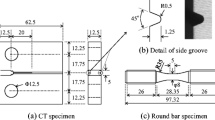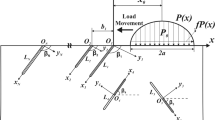Abstract
This paper presents crack shapes development of 3D surface semielliptical cracks which are always found at the weld toe of non-load-carrying cruciform welded joints. The alternating current potential drop technique has been used to measure the eight crack depths along the weld toe where probes are placed at 10-mm intervals. 3D crack shapes can be obtained at any particular cycle during the fatigue test. Subregion boundary element methods incorporating the transition and quarter-point elements along the crack front are used to validate the experimental stress intensity factors along the crack front. A method for evaluating the effective stress intensity factors is proposed. It is found that the numerical results generally agree with the experimental results.
Similar content being viewed by others
References
Goh, M. L. and Abdat, S. B. S., “Fatigue Analysis of Class F and F2 Fillet Welded Attachments,” Final year Project Report, School of Civil & Structural Engineering, Nanyang Technological University (1994).
Dover, W. R. and Collins, R., “Recent Advances in Detection and Sizing of Cracks Using Alternating Current Field Measurement,” British Journal of Non-destructive Testing, Nov. 291–295 (1988).
Ma, C. N., Kam, J. C. P., “Crack Shape Evolution in Tubular Welded Joints,”Non-destructive Testing & Evaluation International,24 (6),291–302 (1991).
Yeo, W. L., “Monitoring the Crack Growth Using the ACPD Equipment-Effect of Transverse Attachment,” Final Year Project Report, School of Civil & Structrual Engineering, Nanyang Technological University (1998).
Yeoh, W. T., “Monitoring the Crack Growth Using the ACPD/ACFM Equipment,” Final Year Project Report, School of Civil & Structural Engineering, Nanyang Technological University (1998).
Gurney, T. R., Fatigue of Welded Structures, 2d ed., Cambridge University Press, Cambridge, UK (1979).
BS7608. Fatigue Design and Assessment of Steel Structures, British Standard Institution, London, UK (1993).
Zhu, H., “On Three Dimensional Crack Analysis by Boundary Element Method and Some Engineering Applications,” MEng Thesis, Tsinghua University (1987).
Cen, Z. Z., Qin, F. andDu, Q. H., “Two Dimensional Stress Intensity Factor Computations by Multi-domain Boundary Element Method for Crack Closure with Friction,”Acta Mechanica Solida Sinica,2,189–202 (1989).
Lie, S. T., Li, G., and Cen, Z. “Modelling Tubular Joints Using a Combination of Finite and Boundary Elements, Theory and Application of Boundary Element Methods,” Proc. of the Eight China-Japan Symposium on BEM, Beijing, China, May 11–15, pp. 257–266 (1998).
Technical Software Consultant Ltd., ACFM Crack Microgauge-Model U10 User Manual, Milton Keynes, UK (1991).
Technical Software Consultant Ltd., FLAIR User Manual-Software Version 1.9, The Open University, Milton Keynes, UK (1998).
Kane, J. H., Boundary Element Analysis in Engineering Continuum Mechanics, Prentice Hall, Englewood Cliffs, NJ (1994).
Aliabadi, M. H. andRooke, D. P., Numerical Fracture Mechanics, Computational Mechanics Publications, Southampton, UK. (1991).
Tanaka, K., “Fatigue Crack Propagation from a Crack Inclined to the Cyclic Tensile Axis,”Engineering Fracture Mechanics,6,493–507 (1974).
Weertman, J., “Rate of Growth of Fatigue Cracks Calculated from the Theory of Infiniterimal of Dislocations Distributed on a Plane,”International Journal of Fracture,2,460–467 (1966).
Lardner, R. W., “A Dislocation Model for Fatigue Crack Growth in Metals,”Philosophical Magazine,17,71–82 (1968).
Gerstle, W. H., Finite and Boundary Element Modeling of Crack Propagation in Two and Three Dimensions Using Interactive Computer Graphics, PhD thesis, Cornell University, Ithaca, NY (1986).
Bowness, D. andLee, M.M.K., “Fatigue Crack Curvature under the Weld Toe in an Offshore Tubular Joint,”International Journal of Fatigue,20,481–490 (1998).
Author information
Authors and Affiliations
Rights and permissions
About this article
Cite this article
Lie, S.T., Chiew, S.P., Xiang, Z. et al. Fatigue crack shapes development of plate-to-plate welded joints. Experimental Mechanics 41, 114–121 (2001). https://doi.org/10.1007/BF02323113
Received:
Revised:
Issue Date:
DOI: https://doi.org/10.1007/BF02323113




